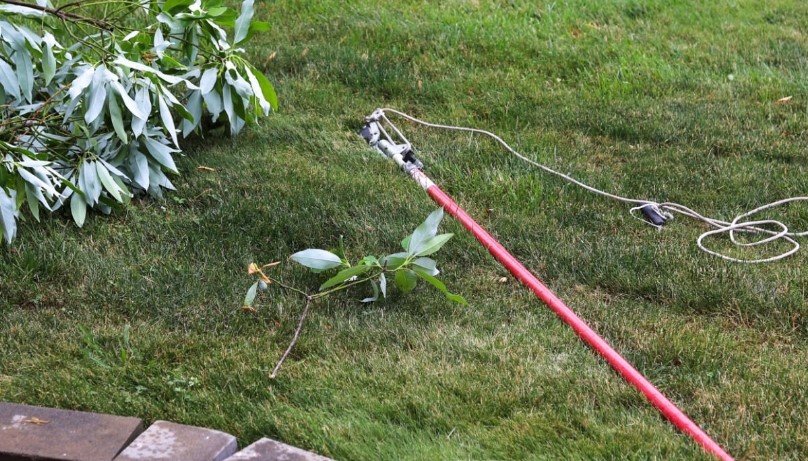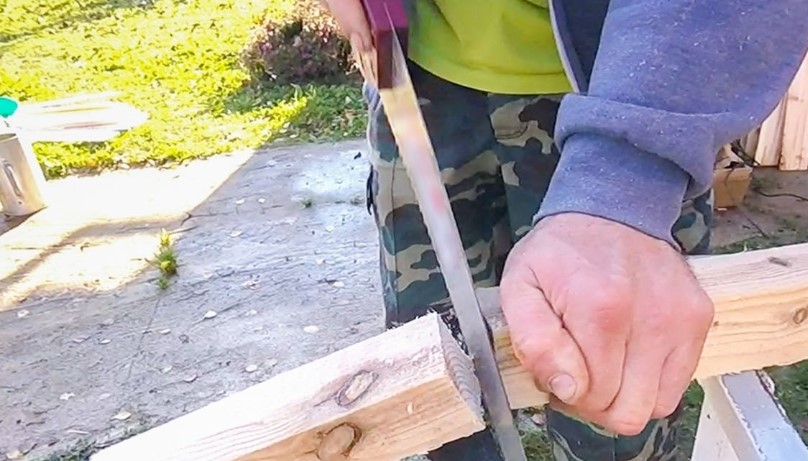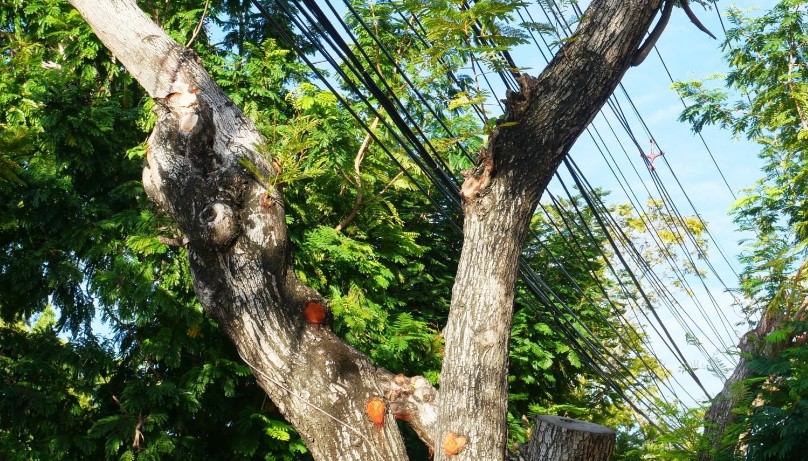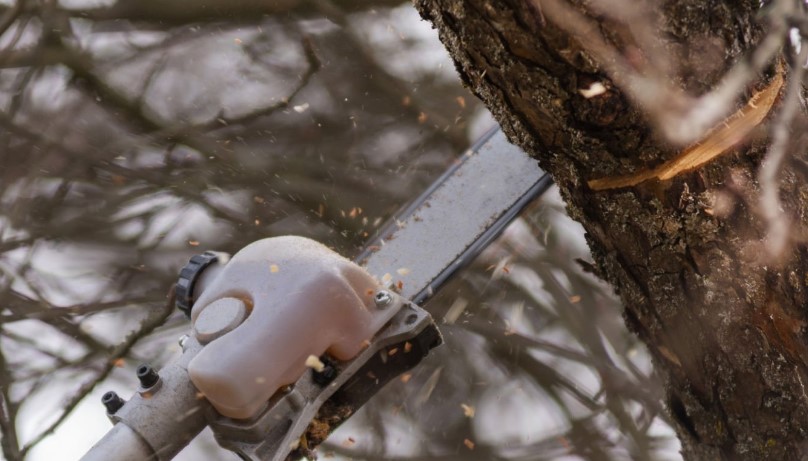How to Use a Pole Saw – Expert Tips for Proper Usage
A pole chain saw may be a handy tool in your toolbox if you’re trying to trim trees precisely and get to those hard-to-reach limbs. You can easily prune trees and take care of your outside area with the help of this adaptable equipment, which combines the strength of a chainsaw with an extendable pole. In this guide, we’ll give you a lead through how to use a Pole Saw – Expert tips for proper usage. Let’s join Bebest to delve into the world of pole chain saws and unlock the secrets to successful operation and maintenance.
How to Use a Pole Saw
A pole saw is an invaluable tool for the precise pruning of trees and shrubs, eliminating the need for precarious ladder use. However, it demands a meticulous approach to safety to avoid potential hazards. Here’s a comprehensive breakdown of steps to employ a pole chain saw with both effectiveness and caution.
Step 1: Precautions
The foundational step in safely operating a pole chain saw involves meticulous preparation. You need to read the manufacturer’s specific guidelines for your particular tool model. Thanks to this, you can get the hang of its functionalities.
Before you delve into the task at hand, conduct a thorough weather assessment, steering clear of conditions that could compromise your safety, such as strong winds, rain, or storms.
Besides, it is necessary to ensure you have an ample supply of fuel and oil for your pole chain saw to sustain uninterrupted operation. A crucial aspect of safety and effectiveness lies in the condition of the chain. Confirm it is impeccably sharpened and tensioned according to specifications. This careful attention to detail sets the stage for a secure and productive cutting session.

Step 2: Prepare Your Work Area
A secure work environment is paramount. You must survey your surroundings to select a suitable, level terrain free from potential hazards. When you see any obstructions that might impede your movement or pose a danger, such as rocks, branches, or wires, you need to eliminate them.
Identify the branches and limbs earmarked for trimming, devising a strategic plan for their removal. This proactive approach enhances efficiency and minimizes risks. As you designate your cutting sequence, avoid power lines, buildings, vehicles, and individuals within the vicinity. By meticulously preparing your work area, you pave the way for a controlled and safe cutting process.
Step 3: Prepare Your Pole Saw
Optimal performance hinges on the meticulous setup of your pole chain saw. Begin by customizing the pole’s length to suit your reach and the height of the branches. Secure the pole with precision, guaranteeing it maintains a balanced and manageable configuration. Prior to initiating any cutting, start the engine and allow it a brief warm-up period, promoting smooth and efficient operation.
Conduct a comprehensive assessment of key components, such as the throttle and chain brake, to ensure they are in pristine working condition. This proactive measure mitigates unexpected complications during the operation, elevating your level of control and safety. By attentively preparing your pole saw, you lay the foundation for a productive and secure cutting experience.

Step 4: Protect Yourself
The paramount concern in pole chain saw operation is your personal safety. Equipping yourself with appropriate protective gear is non-negotiable. Don gloves, goggles, a helmet, earplugs, long sleeves, pants, and sturdy boots to shield yourself from potential hazards. Eliminate any loose clothing, accessories, or items that could inadvertently become entangled with the chain or cutting components.
Maintain a vigilant awareness of your body’s position in relation to the saw. Always maintain a safe distance from the chain and cutting head, ensuring your hands are securely positioned away from harm’s way. By adhering to these precautions, you bolster your defenses against potential accidents and enhance your confidence in managing the tool.
Step 5: Assume the Correct Cutting Position
Establishing a proper stance and grip is pivotal to executing clean and safe cuts. Position your feet shoulder-width apart on stable ground with your knees slightly bent, facilitating balance and stability. After that, you need to grasp the pole saw with both hands, locking your elbows to enhance control and precision.
As you engage with the cutting task, avoid overextending or cutting above your head, which can compromise stability and control. Maintain the pole saw at a right angle to the branch, aligning the cutting head meticulously with the intended cutting point. This optimal posture fortifies your ability to manage the tool effectively and execute accurate cuts.
Step 6: Using the Pole Saw to Cut Branches and Limbs
Initiating a cut necessitates crafting a shallow notch on the underside of the branch, approximately a foot away from the trunk. This preliminary notch curbs the likelihood of unwanted splitting or tearing as the branch descends.
Transition to the top of the branch, executing a clean cut that extends slightly beyond the initial notch. This methodical technique minimizes the risk of jagged or uneven cuts, resulting in a more controlled branch descent. Allow the branch to fall naturally, avoiding any attempts to manipulate its trajectory. Use this systematic process for each designated branch or limb, contributing to a seamless and secure pruning endeavor.

Step 7: The Clean-Up
Concluding your cutting tasks calls for a careful wrap-up process. As you deactivate the engine, grant the pole saw ample time to cool down before any subsequent handling. Utilize a brush and cloth to meticulously cleanse the cutting head and chain, maintaining their functionality and prolonging their lifespan.
Thoroughly inspect the pole saw for any signs of damage or wear, addressing any issues promptly to ensure continued safe and effective operation. Once cleaned and inspected, store the pole saw in a dry and secure location, safeguarding it from potential elements of corrosion or damage.
Pole Saw Safety Tips
If you’re embarking on the task of tree trimming with a pole saw, adhering to a set of crucial safety guidelines is paramount to circumvent potential accidents and injuries. Here are some of the most imperative tips to ensure your well-being while effectively wielding this tool:
Wear protective gear
Prioritize your personal safety by outfitting yourself with essential protective gear. Equip a sturdy helmet to shield your head, gloves to safeguard your hands, and goggles to shield your eyes from falling debris. Long sleeves and pants offer an additional layer of protection against potential scratches and abrasions. This ensemble of safety attire acts as a robust defense against not only descending branches but also the sharp saw blade itself.

Check the weather
Refrain from wielding your pole saw under adverse weather conditions. Steer clear of using it during windy, rainy, or stormy weather. Unpredictable gusts of wind can alter the trajectory of branches, posing unforeseen risks. Similarly, rain can render the pole slippery and impede your visibility, compromising your control over the tool. Exercise patience and wait for a calm and clear day before embarking on your tree-pruning endeavors.
Inspect the pole saw
An integral facet of safe operation lies in a meticulous inspection of your pole saw prior to commencing cutting activities. Scrutinize the tool for any visible damage or defects. Ensure that the saw blade is sharp and devoid of any debris that might impede its functionality. Lubricate and tension the chain appropriately to optimize its cutting performance.
If you are using a battery-operated model, ascertain that the battery is fully charged, or if using a corded saw, ensure that the cord is securely plugged in. Address any identified issues promptly, rectifying them or opting for a replacement pole saw if necessary.
Choose a stable position
Your positioning and footing play a pivotal role in the safe operation of a pole saw. Stand firmly on a stable and level surface, forsaking the use of ladders, stools, or uneven terrain that can compromise your balance. Uphold a safe distance from the branch you intend to cut, and firmly grasp the pole with both hands, holding it at chest level. This firm grip, combined with a stable stance, fortifies your control over the tool and minimizes the likelihood of accidents.

Cut with Precision and Care
Exercise prudence and precision during the cutting process to ensure optimal results without compromising safety. Adhere to the principle of cutting one branch at a time, maintaining a methodical approach. Employ smooth and steady strokes to avoid abrupt movements that could destabilize your position. Prioritize branches that are within the appropriate thickness and height range for your pole saw, steering clear of those that exceed its capacity. To prevent potential hazards, abstain from cutting branches situated above your head or in close proximity to power lines.
Upon completion of each cut, gradually lower the pole saw while maintaining control over its movement. Engage the safety measures by switching off the saw, mitigating the risk of accidental activation. The synergy of cautious execution and meticulous attention to detail will ensure not only your safety but also the successful outcome of your tree trimming endeavor.
FAQs
If you love gardening and landscaping, you might have wondered about pole saws. Pole saws are tools allowing you to cut branches and limbs that are out of your reach. They are not hard to use, but they do require some safety precautions and techniques. Here are some answers to common questions about pole saws.
Are pole saws hard to use?
No, pole saws are not hard to use, but they do require some practice and skill. You need to make sure that the pole is stable and balanced and that you have a firm grip on the handle. It is imperative to equip oneself with proper protective gear, including gloves, goggles, and a helmet. These measures are essential in preventing injuries that may arise from falling branches or debris.

Can I use a pole saw to chop limbs of what size?
The size of the limb that you can cut with a pole saw depends on the power and capacity of your saw. Generally, pole saws can cut limbs that are up to 6-8 inches in diameter, but some models can handle larger limbs. You should always check the specifications of your saw before attempting to cut a limb that is too thick or heavy.
What can you do with a pole saw?
Pole saws are versatile tools that can help you with various gardening and landscaping tasks. Some of the things that you can do with a pole saw are:
- Prune trees and shrubs that are overgrown, diseased, or dead. This can improve their health, appearance, and growth.
- Trim hedges and bushes that are too tall or wide. This can create a neat and tidy look for your garden or yard.
- Cut firewood or lumber from fallen or unwanted trees. This can provide you with fuel or material for your projects.
- Clear branches or limbs that are blocking your view, sunlight, or access. This can enhance your safety and comfort.
Conclusion
Mastering the art of using a pole chain saw is not just about convenience; it’s a blend of skill, caution, and a deep respect for safety. This guide has taken you on a journey on how to use a Pole Saw – expert tips for proper usage.
In the realm of tree maintenance, a pole chain saw is a valuable ally, granting you the power to sculpt nature’s beauty. But with great power comes even greater responsibility – the responsibility to prioritize safety, plan meticulously, and execute with care. Armed with the knowledge shared in this guide, you’re now equipped to navigate the world of pole chain saws confidently and skillfully. So, go forth, trim, and shape, all while embracing the art of safe and effective pole chain saw usage.
Related Articles